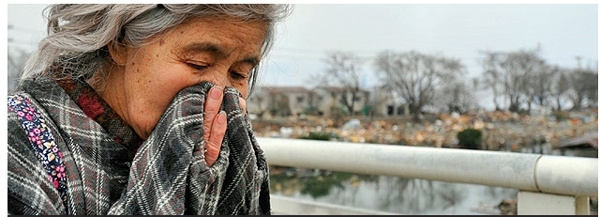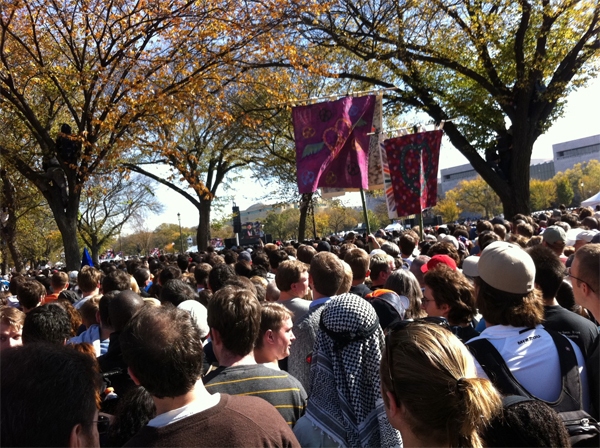The space vehicle is shoddily constructed, running dangerously low on fuel; its parachutes — though no one knows this — won’t work and the cosmonaut, Vladimir Komarov, is about to, literally, crash full speed into Earth, his body turning molten on impact. As he heads to his doom, U.S. listening posts in Turkey hear him crying in rage, cursing the people who had put him inside a botched spaceship. . . .
In 1967, both men [Komarov and Gagarin] were assigned to the same Earth-orbiting mission, and both knew the space capsule was not safe to fly. Komarov told friends he knew he would probably die. But he wouldn’t back out because he didn’t want Gagarin to die. Gagarin would have been his replacement.
Nuclear Crisis In Japan – Slo Mo Crisis Of Tangible Things
Perhaps it’s the linguistic barriers; parachuting anchors into Japan probably don’t even have Japanese tourist phrasebooks. But it’s amazing how absent Japanese people, officials or volunteers are from newscasts. A speech from the Japanese Prime Minister announcing the Fukushima reactors are at a crisis point didn’t merit coverage. By contrast, earlier ramblings of a tribal dictator fighting over empty sand? Wall to wall saturation.
Perhaps we’re overly critical of American news media (primarily broadcast). Yet our impression is of Americans talking primarily to Americans standing in debris fields without Japanese faces, voices or perspectives. American broadcasters in Egypt found translators and interviewed protestors, covered Mubarak addresses, etc. Yet the greatest natural disaster in modern times happens to be in a Japan without many Japanese on camera. So far.
There are vague references to homeless. And people without food, water, medicine, heat. Little coverage on what’s actually being done, what needs to be done. The difference with coverage in Haiti is stark. Perhaps because the Japanese social contract removes ‘good tv’ images of conflict, riots, or looting.
Instead, American networks latch onto more easily covered tangible things such as exploding nuclear reactors. Broadcast producers appear to book anyone with ‘nuclear’ in their job title, from disarmament types to nuclear power (pro or con) lobbyists. It’s a two-fer if the commentator is a physicist. Unsurprisingly the commentary about the Dai Ichi plants presents more chyron alarm than clarity – exchanges of ignorance.
A corollary to the American fixation on tangible Japanese buildings is obsession on what it means for us. Should California prepare for nuclear fallout? Could California plants at Diablo Canyon survive a 9.0 earthquake and tsunami? How will Californians buy a Prius going forward? What happens to Americans’ 401ks? And perhaps most salient to Americans, how will the crisis affect their plans to buy an iPad 2?
We don’t dismiss a nuclear crisis verging close to a true meltdown. That desperate situation, however, will unfold over considerable time. Should matters continue to deteriorate the damage and clean up will be a challenge for years. Meanwhile tsunami survivors, homeless, without shelter, food, water or medicine either get needed help or succumb. Which prompts the question, ‘If catastrophe victims get help and American tv doesn’t cover them, were they ever in danger?’
The Boy King (And Democrats) Want Us To Follow Them Into The Desert
You know you’ve been thinking the same thing.
If only a primary challenge was more than a sophomoric reflex. The Democratic ‘Party’ as political construct is a dysfunctional, dissipated golem. 6 more years? Who wants to contemplate just another 2?
___
n.b. Another blank on your iGadget? Kvetch to Steve Jobs per usual.
Fun, Strange Rally On The Mall
A fun and definitely over crowded day on the Mall for Stewart and Colbert. Their demographics are astonishing. Jammed in the Metro we met teenagers who drove in from Philly this AM, other college students who drove ten hours overnight, to soccer moms, Volvo dads and everyone in between. All contagiously upbeat and polite.
Once on the Mall, we were amazed at the crowd’s size. Most of the crowd only saw the back of someone else’s head: the Jumbotrons way too few and distant. An anemic PA system couldn’t deliver the copious dialogue despite initially pleading chants ‘louder, louder’. Even the music came across like a small AM radio. People still had fun. Wherever we went, the crowd gave up trying to hear the program and happily chatted amongst themselves and friendly strangers. People caught highlights on the wind – Cat Stevens, Ozzy, R2/D2, etc.
So some observations. Lesson One: always bring more PA than you think you need. You can always dial it back. Jagger, Townshend, Page and Gilmour learned that 40 years ago first playing stadiums.
Lesson Two: there’s a reason that comedians don’t do stadium shows – it doesn’t work. Much of comedy must be seen, ‘felt’ as well as heard. No matter how funny something probably looked to viewers watching TV, for those who can’t see the stage/a Jumbotron and hear only every third word, a 10 minute routine turns into a unintelligible, endless drone. Skits simply don’t translate to mass standing audiences, packed like sardines. Even with a working PA and more Jumbotrons. And there were too many.
Lesson Three: successful stadium rocker vets know a massive crowd assumes a unique organic identity. Carrying a show over to large audiences requires completely different considerations re pacing and careful building to/easing from crescendos.
Still we and all we saw enjoyed the day. People seemed content just being there, knowing Jon Stewart and Colbert were somewhere in the crowd doing their thing. All around us the audience stayed happily to the end. If Stewart’s closing monologue veered into meandering ‘Jazz Odyssey’ territory at times, he recovered (as did the PA, a bit). It’s odd to galvanize a mass audience to gather from across the nation and close with a plea to be reasonable. Stewart himself admitted he is confused by the purpose. Most stadium acts aim for a more specific emotional release.
The organizers wisely closed with the always terrific The Staples Singers’ I’ll Take You There. Hard to beat that. Time well spent.
Pertinent Question: Are Our Writers As Lousy As Our Bankers?
Are Our Writers As Lousy As Our Bankers?
by Evert Cilliers aka Adam Ash
There is a certain kind of art made here in America for a lofty but banal purpose: to enliven the contemporary educated mind.
You know: the mind of you and me, dear 3QD reader — the NPR listener, the New Yorker reader, the English major, the filmgoer who laps up subtitles, the gallery-goer who can tell a Koons from a Hirst.
This art is superior to the cascading pile of blockbuster kitsch-dreck-crap that passes for pop culture, but only superior by a few pips.
This art sure ain’t Picasso, or Joyce, or Rossellini, or the Beatles, or even Sondheim. It’s more Woody Allen than Ingmar Bergman, more Joyce Carol Oates than James Joyce, more Jeff Koons than Duchamp, more Arcade Fire than the Beatles.
It does not expand the borders of art or wreck the tyranny of the possible or enlarge our hungry little minds.
It is art of the day to inform the conversation of the day by the people of the day who need to be reassured that their taste is a little more elevated than that of the woman on the subway reading Nora Roberts.
For want of a better label, here’s a suggested honorific for this kind of art:
Urban Intellectual Fodder.
- « Previous Page
- 1
- …
- 5
- 6
- 7
- 8
- 9
- …
- 11
- Next Page »

